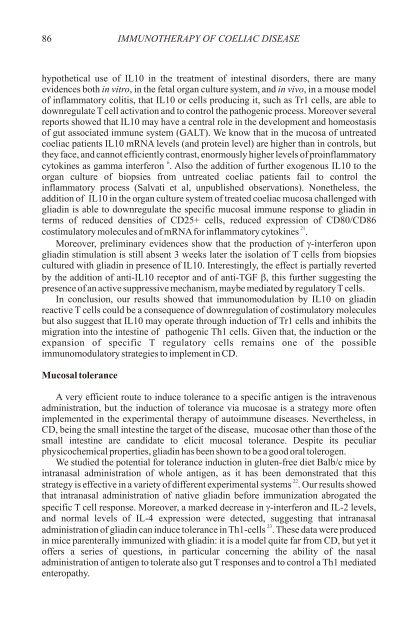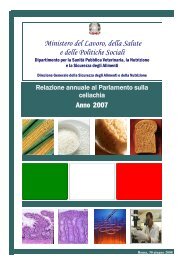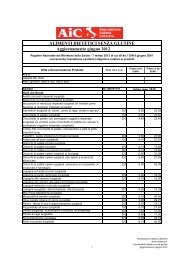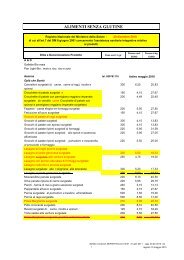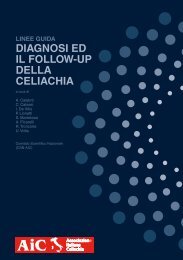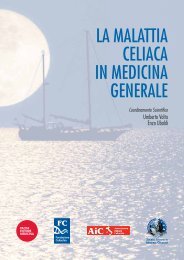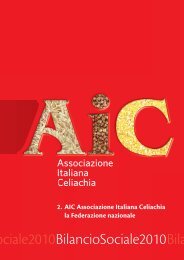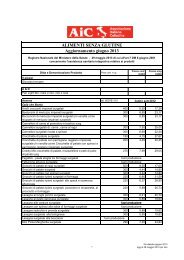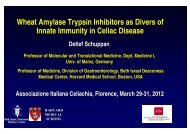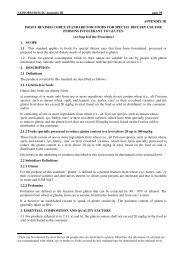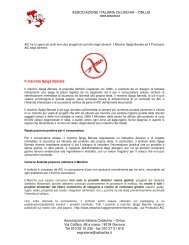primary prevention of coeliac disease - Associazione Italiana ...
primary prevention of coeliac disease - Associazione Italiana ...
primary prevention of coeliac disease - Associazione Italiana ...
You also want an ePaper? Increase the reach of your titles
YUMPU automatically turns print PDFs into web optimized ePapers that Google loves.
86 IMMUNOTHERAPY OF COELIAC DISEASE<br />
hypothetical use <strong>of</strong> IL10 in the treatment <strong>of</strong> intestinal disorders, there are many<br />
evidences both in vitro, in the fetal organ culture system, and in vivo, in a mouse model<br />
<strong>of</strong> inflammatory colitis, that IL10 or cells producing it, such as Tr1 cells, are able to<br />
downregulate T cell activation and to control the pathogenic process. Moreover several<br />
reports showed that IL10 may have a central role in the development and homeostasis<br />
<strong>of</strong> gut associated immune system (GALT). We know that in the mucosa <strong>of</strong> untreated<br />
<strong>coeliac</strong> patients IL10 mRNA levels (and protein level) are higher than in controls, but<br />
they face, and cannot efficiently contrast, enormously higher levels <strong>of</strong> proinflammatory<br />
6<br />
cytokines as gamma interferon . Also the addition <strong>of</strong> further exogenous IL10 to the<br />
organ culture <strong>of</strong> biopsies from untreated <strong>coeliac</strong> patients fail to control the<br />
inflammatory process (Salvati et al, unpublished observations). Nonetheless, the<br />
addition <strong>of</strong> IL10 in the organ culture system <strong>of</strong> treated <strong>coeliac</strong> mucosa challenged with<br />
gliadin is able to downregulate the specific mucosal immune response to gliadin in<br />
terms <strong>of</strong> reduced densities <strong>of</strong> CD25+ cells, reduced expression <strong>of</strong> CD80/CD86<br />
21<br />
costimulatory molecules and <strong>of</strong> mRNA for inflammatory cytokines .<br />
Moreover, preliminary evidences show that the production <strong>of</strong> g-interferon upon<br />
gliadin stimulation is still absent 3 weeks later the isolation <strong>of</strong> T cells from biopsies<br />
cultured with gliadin in presence <strong>of</strong> IL10. Interestingly, the effect is partially reverted<br />
by the addition <strong>of</strong> anti-IL10 receptor and <strong>of</strong> anti-TGF b, this further suggesting the<br />
presence <strong>of</strong> an active suppressive mechanism, maybe mediated by regulatory T cells.<br />
In conclusion, our results showed that immunomodulation by IL10 on gliadin<br />
reactive T cells could be a consequence <strong>of</strong> downregulation <strong>of</strong> costimulatory molecules<br />
but also suggest that IL10 may operate through induction <strong>of</strong> Tr1 cells and inhibits the<br />
migration into the intestine <strong>of</strong> pathogenic Th1 cells. Given that, the induction or the<br />
expansion <strong>of</strong> specific T regulatory cells remains one <strong>of</strong> the possible<br />
immunomodulatory strategies to implement in CD.<br />
Mucosal tolerance<br />
A very efficient route to induce tolerance to a specific antigen is the intravenous<br />
administration, but the induction <strong>of</strong> tolerance via mucosae is a strategy more <strong>of</strong>ten<br />
implemented in the experimental therapy <strong>of</strong> autoimmune <strong>disease</strong>s. Nevertheless, in<br />
CD, being the small intestine the target <strong>of</strong> the <strong>disease</strong>, mucosae other than those <strong>of</strong> the<br />
small intestine are candidate to elicit mucosal tolerance. Despite its peculiar<br />
physicochemical properties, gliadin has been shown to be a good oral tolerogen.<br />
We studied the potential for tolerance induction in gluten-free diet Balb/c mice by<br />
intranasal administration <strong>of</strong> whole antigen, as it has been demonstrated that this<br />
22<br />
strategy is effective in a variety <strong>of</strong> different experimental systems . Our results showed<br />
that intranasal administration <strong>of</strong> native gliadin before immunization abrogated the<br />
specific T cell response. Moreover, a marked decrease in g-interferon and IL-2 levels,<br />
and normal levels <strong>of</strong> IL-4 expression were detected, suggesting that intranasal<br />
23<br />
administration <strong>of</strong> gliadin can induce tolerance in Th1-cells . These data were produced<br />
in mice parenterally immunized with gliadin: it is a model quite far from CD, but yet it<br />
<strong>of</strong>fers a series <strong>of</strong> questions, in particular concerning the ability <strong>of</strong> the nasal<br />
administration <strong>of</strong> antigen to tolerate also gut T responses and to control a Th1 mediated<br />
enteropathy.


